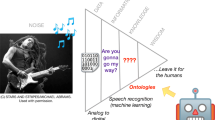Abstract
Multi-domain spoken dialogue is a challenging field where the objective of the most proposed ideas is to mimic the human–human dialogue. This paper proposes to tackle the domain selection problem in the context of multi-domain spoken dialogue as a set theory problem to resolve. First, we built each dialogue domain as an ontology following an architecture with some rules to respect. Second, each ontology is considered as a set and its concepts are the elements. Third, an ontology-based classifier is used to map the user sentence into a set of ontologies concepts and to generate an intersection between these concepts. Finally, a new turn analysis and domain selection algorithm is proposed to infer the intended domain from the user sentence using the intersection set and three techniques, namely Domain Rewards, Dominant Concept, and Current Domain. To evaluate the proposed approach, a corpus of 120 simulated dialogues was built to cover four application domains. In our experiment, the assessment of the system is performed by considering all possibilities of a natural verbal interaction where a changing of semantic context occurs during the dialogue. The obtained results show that the system accuracy reaches a satisfactory performance of 83.13% while the average number of turns by dialogue is 6.79.












Similar content being viewed by others
Explore related subjects
Discover the latest articles, news and stories from top researchers in related subjects.References
Ai H, Weng F (2008) User simulation as testing for spoken dialog systems. In: Proceedings of the 9th sigdial workshop on discourse and dialogue (pp. 164–171)
De Marneffe M-C, Dozat T, Silveira N, Haverinen K, Ginter F, Nivre J et al (2014) Universal stanford dependencies: a cross-linguistic typology. In: Lrec, vol. 14, pp 4585–4592
De Marneffe M-C, Manning CD (2008) Stanford typed dependencies manual (Tech. Rep.). Technical report. Stanford University, Stanford
Dzikovska MO, Allen JF and Swift MD (2003) Integrating linguistic and domain knowledge for spoken dialogue systems in multiple domains. In: Proceeding of ijcai-03 workshop on knowledge and reasoning in practical dialogue systems
Dzikovska MO, Allen JF, Swift MD (2007) Linking semantic and knowledge representations in a multi-domain dialogue system. J Logic Comput 18(3):405–430
Gašić M, Mrkšić N, Rojas-Barahona LM, Su P-H, Ultes S, Vandyke D et al (2017) Dialogue manager domain adaptation using gaussian process reinforcement learning. Comput Speech Lang 45:552–569
Gruber TR et al (1993) A translation approach to portable ontology specifications. Knowl Acquis 5(2):199–220
Hakkani-Tür D, Tur G, Heck L, Fidler A, Celikyilmaz A (2012) A discriminative classification-based approach to information state updates for a multi-domain dialog system
Hastie H (2012) Metrics and evaluation of spoken dialogue systems. Data-driven methods for adaptive spoken dialogue systems. Springer, New York, pp 131–150
Hiraoka T, Neubig G, Yoshino K, Toda T, Nakamura S (2017) Active learning for example-based dialog systems. Dialogues with social robots. Springer, New York, pp 67–78
Jiang R, Banchs RE, Kim S, Yeo KH, Niswar A, Li H (2014) Web-based multimodal multi-domain spoken dialogue system. In: Proceedings of 5th international workshop on spoken dialog systems
Jokinen K, Wilcock G (2016) Dialogues with social robots: enablements, analyses, and evaluation, vol 999. Springer, New York
Komatani K, Kanda N, Nakano M, Nakadai K, Tsujino H, Ogata T et al. (2009) Multi-domain spoken dialogue system with extensibility and robustness against speech recognition errors. In: Proceedings of the 7th sigdial workshop on discourse and dialogue, pp 9–17
Lee C, Jung S, Kim S, Lee GG (2009) Example-based dialog modeling for practical multi-domain dialog system. Speech Commun 51(5):466–484
Lee I, Kim S, Kim K, Lee D, Choi J, Ryu S et al (2014) A two-step approach for efficient domain selection in multi-domain dialog systems. Natural interaction with robots, knowbots and smartphones. Springer, New York, pp 125–131
Lee SRDLI, Lee SHGG, Kim MKK (2012) A hierarchical domain model-based multi-domain selection framework for multi-domain dialog systems. In: 24th international conference on computational linguistics, p 1049
Mrkšić N, Séaghdha DO, Thomson B, Gašić M, Su P-H, Vandyke D et al. (2015) Multi-domain dialog state tracking using recurrent neural networks. arXiv preprint arXiv:1506.07190
Musen MA (2015) The protégé project: a look back and a look forward. AI Matters 1(4):4–12
Planells J, Hurtado LF, Segarra E, Sanchis E (2013) A multi-domain dialog system to integrate heterogeneous spoken dialog systems. In: Interspeech, pp 1891–1895
Ross R, Bateman J (2009) Daisie: information state dialogues for situated systems. In: Text, speech and dialogue, pp 379–386
Shearer R, Motik B, Horrocks I (2008) Hermit: a highly-efficient owl reasoner. In: Owled, vol. 432, p 91
Shi H, Ushio T, Endo M, Yamagami K, Horii N (2017) Convolutional neural networks for multi-topic dialog state tracking. Dialogues with social robots. Springer, New York, pp 451–463
Stanford University (2013) Stanford parser: a statistical parser. In: The Stanford Natural Language Processing Group
Tur G, De Mori R (2011) Spoken language understanding: systems for extracting semantic information from speech. John Wiley & Sons, Hoboken
Wang Z, Chen H, Wang G, Tian H, Wu H, Wang H (2014) Policy learning for domain selection in an extensible multi-domain spoken dialogue system. In: Emnlp, pp 57–67
Yakoub MS, Selouani S-A, Nkambou R (2014) Ontology and parser dependencies approach for spoken dialogue system. In: Signal processing and information technology (isspit), 2014 ieee international symposium on, pp 000167–000172
Yakoub MS, Selouani S-A, Nkambou R (2015) Mobile spoken dialogue system using parser dependencies and ontology. Int J Speech Technol 18(3):449–457
Author information
Authors and Affiliations
Corresponding author
Rights and permissions
About this article
Cite this article
Sidi Yakoub, M., Selouani, S.A. Ontology-based framework for a multi-domain spoken dialogue system. J Ambient Intell Human Comput 15, 1543–1565 (2024). https://doi.org/10.1007/s12652-017-0625-y
Received:
Accepted:
Published:
Issue Date:
DOI: https://doi.org/10.1007/s12652-017-0625-y




